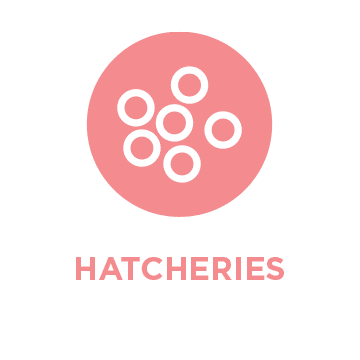Raven McAdams and Alex Juan, graduate students at Cal Poly Humboldt, are on the frontlines of efforts to save struggling salmon populations in the South Fork Eel River from threats from invasive pikeminnow. Raven and Alex are working alongside their mentors, Rafael Cuevas Uribe and Andre Buchheister both professors at Cal Poly Humboldt, on a project exploring the Trojan Y method - a potentially groundbreaking approach to eradicate pikeminnow from the South Fork Eel River. The Trojan Y method aims to sex-reverse pikeminnow to produce only male offspring, eventually leading to the collapse of the population.
Before this approach can be applied, researchers must determine how feasible the Trojan Y method is for the removal of pikeminnow from the Eel. Alex is investigating this exact topic through the development and application of computer simulation models. “Basically, before we actually start doing any Trojan Y stocking, we should know what might happen when we do — and if it's even a good idea or not,” he explains.
His first summer of research was spent collecting and analyzing pikeminnow samples to better understand pikeminnow biology including length-at-maturity, mortality rates, and more. He uses this data to enhance the accuracy of his model – and this deeper understanding of pikeminnow biology ended up becoming the first chapter of his thesis.
Alex sees this project as a step into the “new frontier” of invasive species management. “Genetic biocontrol methods like Trojan Y have the potential to solve invasive species problems that more "traditional" methods could never dream of — such as pikeminnow in the Eel,” he shares. “It's exciting to be working on something that has a possibility of being the answer to a seemingly insurmountable problem.”
In conjunction with Alex’s modeling work, Raven is spearheading the hands-on work of creating these Trojan Y pikeminnow in the university lab's hatchery. The hormone treatments and chromosome manipulation required in the lab to yield the appropriate outcome can be painstaking work. But for Raven, the opportunity to contribute to salmon conservation is deeply meaningful. "I'm a big fan of enhancing my understanding of animal husbandry and fish disease. For me, this project is a great learning experience, not only just to get my hands on these techniques, but also for me to learn how to diagnose illnesses, ultrasound the fish, and perform blood draws. I don't think I could get that experience elsewhere."
As the project progresses, Raven's role has become increasingly vital. "Raven is on the frontlines, doing the hands-on work of creating these Trojan Y fish," says Andre. "We're really lucky to have her passion and dedication driving this effort forward."
Pikeminnow can be elusive and intelligent fish, presenting challenges for Raven and the team to work through. "They're very smart, they like to jump, and they're difficult to handle,” she explains. “But the project has been a really great experience so far."
Since Alex spends a lot of time in the field for his position with the Wiyot Tribe, he aids Raven in collecting pikeminnow samples and live fish for the project. In turn, Raven helps Alex out by analyzing some of his samples in the lab. “I think it's been super beneficial for both of us to have another student on the other side of the project,” Alex says.
The project is made possible through the generous support of CalTrout. "Without CalTrout’s support, this project would not be funded," says Rafael. CalTrout's initial funding of the project has allowed the team to leverage additional grants, expanding the scope of their work.
With the guidance of Andre and Rafael, Alex and Raven are steadily advancing the Trojan Y methodology, inching closer to a solution that could help restore balance to the Eel River ecosystem.
“I came straight from Missouri and was swimming around in the South Fork Eel/Lhou’lhaqh before I had ever seen a salmon,” says Alex. “The journey since then has been truly amazing. It really is a special place and a special ecosystem, and I feel very privileged to have the opportunity to work there. Being able to help the system recover is the cherry on top.”
As a member of the Yurok Tribe, Raven has a deep personal connection to the Eel River and its wildlife. "Though the Eel River is not my ancestral territory, it is the ancestral territory of other Tribes, and it is a really important watershed for those Tribes’ food sovereignty,” she explains “I am proud that I can be a part of this program and a part of the solution for this issue we are having in the Eel River."
























 Dams block access to historical spawning and rearing habitats. Downstream, dams alter the timing, frequency, duration, magnitude, and rate of change of flows decreasing habitat quality and survival.
Dams block access to historical spawning and rearing habitats. Downstream, dams alter the timing, frequency, duration, magnitude, and rate of change of flows decreasing habitat quality and survival.